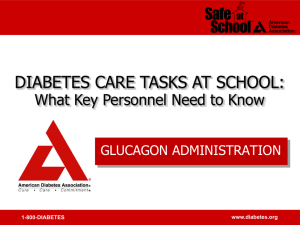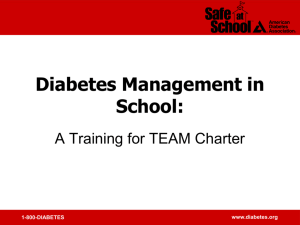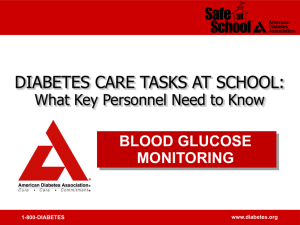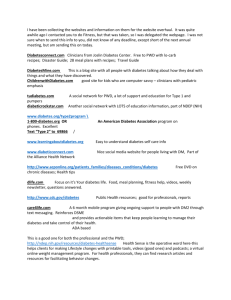Glucagon Administration
advertisement
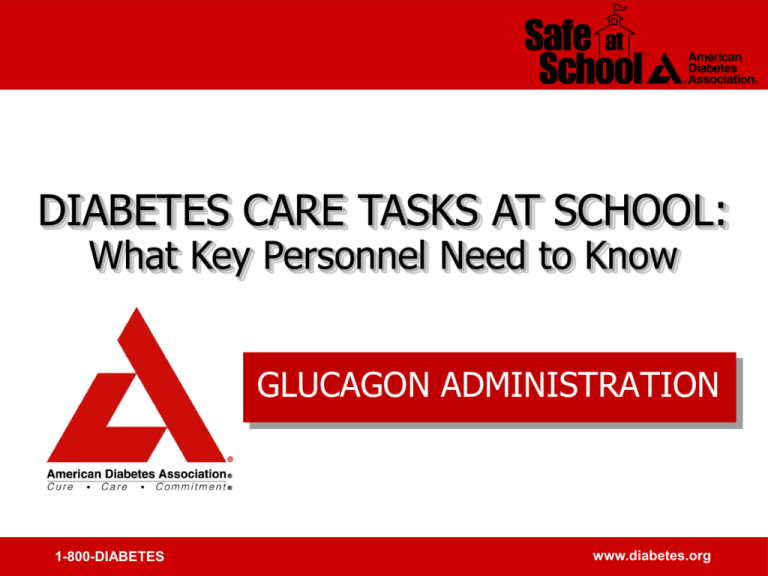
DIABETES CARE TASKS AT SCHOOL: What Key Personnel Need to Know GLUCAGON ADMINISTRATION 1-800-DIABETES www.diabetes.org Goal: Optimal Student Health and Learning Timely glucagon administration, when indicated, is a vital piece of a comprehensive plan. 1-800-DIABETES 2 www.diabetes.org Learning Objectives Participants will be able to understand: • What glucagon is How glucagon should be stored • When glucagon is used • Participants will be able to demonstrate: • How to administer glucagon 1-800-DIABETES 3 www.diabetes.org What Is Glucagon? • Naturally occurring hormone made in the pancreas • A life-saving, injectable hormone, Glucagon/GlucaGen that raises blood glucose level by stimulating the liver to release stored glucose • Treatment for severe hypoglycemia • Life-saving, cannot harm a student – cannot overdose 1-800-DIABETES 4 www.diabetes.org Glucagon or GlucaGen Kit Storage • • • • Place: As designated in DMMP accessible to school personnel Store at room temperature Expiration date: Monitor After mixing, dispose of any unused portion within one hour 1-800-DIABETES 5 www.diabetes.org Emergency Kit Contents: 1 mg of freeze-dried glucagon (Vial) 1 ml of water for reconstitution (Syringe) Combine immediately before use 1-800-DIABETES 6 www.diabetes.org When to Give Glucagon/Glucagen If authorized by the student’s DMMP and if student exhibits: • Unconsciousness, unresponsiveness • Convulsions (seizures) • Inability to safely eat or drink 1-800-DIABETES 7 www.diabetes.org Procedure: Act Immediately • If possible check blood glucose, don’t delay • If in doubt, always treat • Position student safely on side for comfort and protection from injury • School nurse or trained personnel notified to give glucagon in accordance with DMMP or emergency care plan • Call 911, parent/guardian, school nurse as per DMMP or emergency care plan 1-800-DIABETES 8 www.diabetes.org Preparation 1. Flip cap off glass vial containing dry powder 2. Remove cap from syringe 3. Put on gloves if available 1-800-DIABETES 9 www.diabetes.org Mixing Solution 4. Inject entire fluid in syringe into the bottle containing powder 5. Without taking the syringe with a needle out of the vial, gently shake the vial in your hand until the powder has completely dissolved, and the solution is clear. 1-800-DIABETES 10 www.diabetes.org Dosing and Drawing Out 6. Inspect. Solution should be clear and colorless. 7. Draw prescribed amount of glucagon back into syringe. 1-800-DIABETES 11 www.diabetes.org Injecting 8. Clean site if possible. 9. Inject at 90° into the tissue under cleansed area (may administer through clothing as necessary – buttocks – thigh – arm 1-800-DIABETES 12 www.diabetes.org After Injecting 10. May take 10-20 minutes for student to regain consciousness 11. Check blood glucose 12. Give sips of fruit juice or regular soda, once student is awake and able to drink 13. Advance diet as tolerated 14. Document as per DMMP 15. Do not recap syringe. Discard sharp in appropriate container 1-800-DIABETES 13 www.diabetes.org Considerations • The time to complete recovery from a severe hypoglycemic episode varies according to how low the blood glucose level was and for how long prior to treatment • Some signs and symptoms, such as headache, may persist for several hours, although the blood glucose level is satisfactory • Continued monitoring is important • Student may need to be transported via EMS or go home with parent/guardian 1-800-DIABETES 14 www.diabetes.org Don't Be Surprised If. . . • Student does not remember being unconscious, incoherent or has a headache • Blood glucose becomes very high (over 200) • Nausea or vomiting may occur 1-800-DIABETES 15 www.diabetes.org
